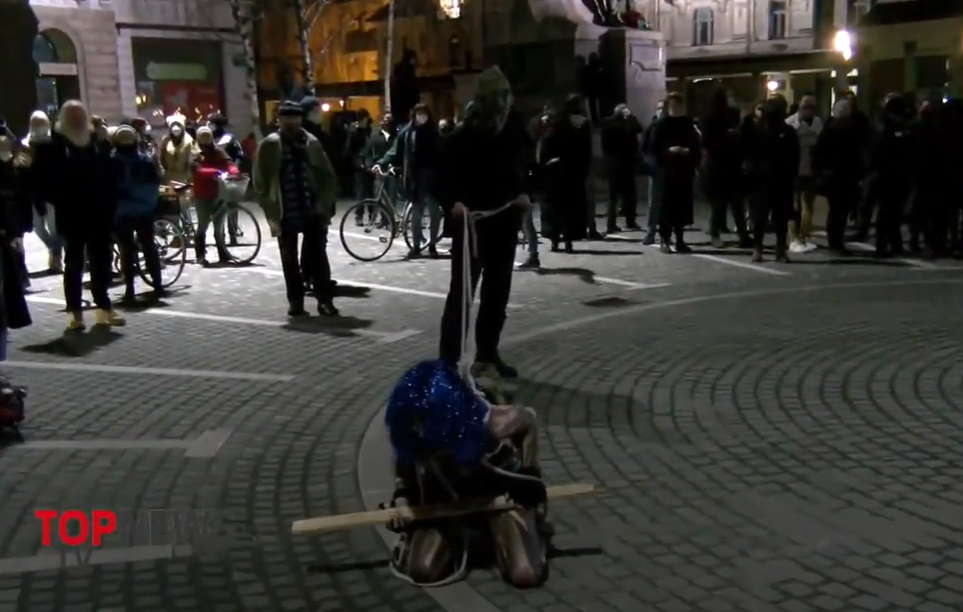Just when a person thinks that nothing can surprise them anymore, along come the Rog squatters, who make sure to prove them otherwise. Despite the fact that the Levica MP Nataša Sukić insists that new ideas, critical thought and things that are extremely important for our society as such were being born in Rog, we were able to see a practical demonstration on the day of culture, which proved that this is definitely not the case. At a rally called The Funeral of Culture, which was organised by the Autonomous Factory (AT) Rog, we saw, among other things, a woman tied up with a rope, who was hysterically screaming. A scene straight from a horror movie.
A post on the Facebook page of the AT Rog invited everyone to a funeral procession on the cultural holiday, the 8th of February, to mark the death of culture. Two hundred supporters gathered, and they walked from the Autonomous Cultural Centre Metelkova City (AKC Metelkova mesto) across Trubarjeva street and the market, STA reports. They then walked past the Town Hall, all the way to Prešeren Square, where they held a bizarre performance, full of hysterical screaming and reciting of a bunch of nonsense.
To je danes izbruhnilo iz globoke latence na ulicah Ljubljane.
Je to kultura? pic.twitter.com/MDAgXZDAKv— Davorin Kopše (@DKopse) February 8, 2021
The procession of the Rog squatters and their supporters, with flowers and candles in their hands, placed a coffin and lit candles in front of the Town Hall, and a second coffin was placed before the statue of our greatest poet, France Prešeren. After their bizarre performance, they went their separate ways. Those who participated in the procession were repeatedly warned that the rally was not registered, and they were also asked to respect the Communicable Diseases Act.
Worshipping culture
According to AT Rog, the City of Ljubljana (Mestna občina Ljubljana – hereinafter referred to as MOL) committed its “latest murder” on the 19th of January, when it “attacked” AT Rog with the security services and the police. “In the name of ‘culture,’ they tried to undermine the roots of the spontaneous cultural, social and political scene in the city. But they forgot that spring is coming. Our seeds have spread everywhere,” the Rog supporters wrote. They also published a statement on Facebook, in which they wrote that three weeks had already passed since their eviction from Rog and claimed that MOL had not shown a single official document during this time, which would prove the legality of the eviction. They emphasised that Rog’s premises were not empty and that the decision in the court proceedings, the one which MOL is referring to, did not constitute a legal basis for the events that transpired on the 19th of January.
The premises of the Rog factory have long been marked with numerous disputes between users and the municipality, which became the owner of the facilities in 2002. The municipality was planning to build a centre at the site of the facilities; however, many groups gathered there and therefore, the building remained abandoned. Let us remind you of certain events that happened. On the day of the demolition, the police had to arrest a couple of people and come to the aid of the security guards, who were trying to make sure that everything was in order and that the construction work could continue uninterrupted. A crowd gathered in front of Rog, to protest the demolition of the old building, for which the Mayor of Ljubljana, Zoran Janković decided. Associate professor and media expert Sandra Bašić Hrvatin was seen at the protest, and she was later also joined by Nataša Sukič, an MP from the Levica party and a city councillor. The protest was also attended by the so-called People’s Assembly, which is actually a group of Jaša Jenull’s followers, which emphasised that Janković’s actions were shameful. “MOL lied to the public, to the elected councillors, and to us, because Rog was not empty and nobody was notified /…/ In the middle of an epidemic and in the middle of winter, it inhumanely evicted people.” The hooligans from the ruins of Rog, where drug addicts and drunks used to gather, also attacked the city’s infrastructure in protest. In doing so, they were not even the slightest bit bothered about the restrictions on movement.
Following Sukić’s initiative, the Levica party even convened a session, where the members of the National Assembly’s Commission for Petitions, Human Rights and Equal Opportunities devoted six hours of discussion to the alleged violations of police powers in the case of the eviction of members of the Rog community. Despite the zealous protesting of the Levica party, the majority took the position that all of this is completely at odds with any logic, as in this case, the premises are owned by the municipality. And despite six attempts at mediation, things did not move forwards, so eviction was bound to happen eventually.
Based on the reactions on social networks, the recent “cultural” performance shocked many people. All of this is far from being art; it seems more like a scene from a psychiatric ward. No wonder that a lot of the posted comments sounded similar to the following ones: “And what is this performance supposed to demonstrate? This is too much. It mostly reminds me of a sad scene from a madhouse. Is it really necessary to distort culture in such a way?”; “Sick. If these people get even one euro cent from the contributions and taxes I pay, I will demand that the government immediately cut off all funding and all possible social transfers. And if it would refuse, then I would suggest that it should abolish all taxes that Slovenian citizens have to pay.”; “These are sickos and not cultural workers, this is really sad… And these are the people who are getting the money from our contributions.”
Nina Žoher


